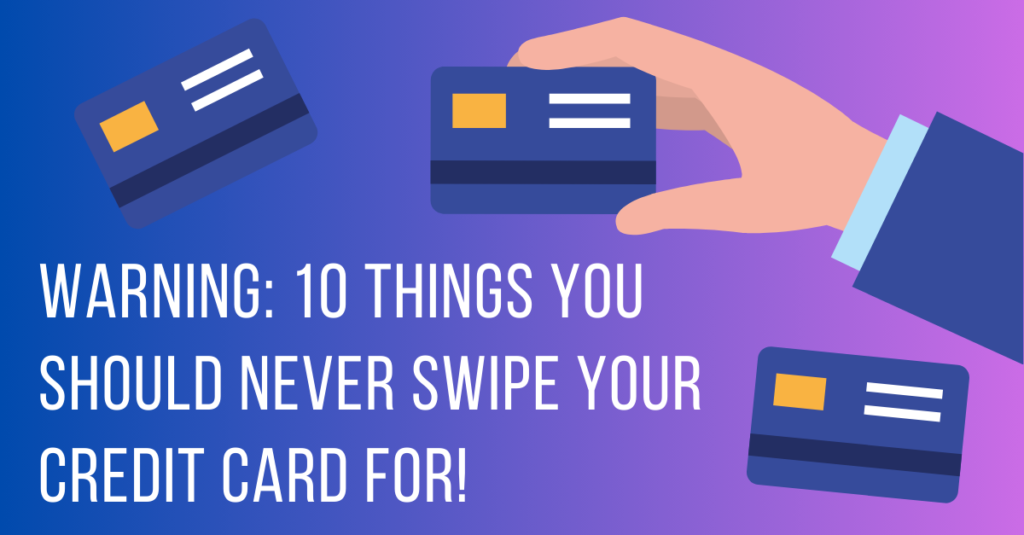Warning: 10 Things You Should NEVER Swipe Your Credit Card For!
Introduction
Welcome to a financial wake-up call! In a world where credit cards offer unparalleled convenience, it’s all too easy to fall into the trap of using them for everything. But hold on – before you swipe that card again, you need to know the 10 things you should NEVER buy with your credit card. This isn’t just about responsible spending; it’s about safeguarding your financial future.
From impulse purchases that drain your wallet to risky investments that could lead to disaster, we’re going to uncover the hidden dangers lurking behind your credit card transactions. It’s a deep dive into financial wisdom, revealing the pitfalls and perils that credit card companies don’t want you to know.
Stay tuned as we uncover these financial landmines and equip you with the knowledge to make smarter, more secure choices. Your financial well-being depends on it!
Warning: 10 Things You Should NEVER Swipe Your Credit Card For!
1. Impulse Purchases
The Danger: Impulse buying is the enemy of your budget. When you whip out your credit card for those “just because” purchases, it’s easy to lose track of your spending, and it can lead to mounting credit card debt.
Why Not: Credit cards make impulse buying dangerously easy. The immediate gratification may feel satisfying, but the long-term consequences can be crippling.
What to Do Instead: If you spot something you want on impulse, take a step back. Give yourself a cooling-off period of a day or two. Often, you’ll find that the urge to buy diminishes. If it doesn’t, you can then decide if it’s worth the purchase and if you can afford it.
2. High-Interest Debt
The Danger: Using a credit card to pay off high-interest debt, such as payday loans or other credit cards, can be a costly mistake. The interest rates on credit cards are typically high, and this strategy can put you into a cycle of debt.
Why Not: You’re essentially swapping one form of high-interest debt for another. The problem doesn’t go away; it only gets shuffled around and becomes harder to manage.
What to Do Instead: Consider debt consolidation loans, which typically come with lower interest rates, to consolidate high-interest debt. This can make your repayment more manageable and less expensive.
3. Medical Bills
The Danger: Using your credit card to pay for medical expenses can be a knee-jerk reaction in times of crisis. However, medical bills can be hefty, and credit cards aren’t the most financially savvy way to manage them.
Why Not: Medical bills can lead to long-term debt, and credit card interest can escalate the financial burden.
What to Do Instead: Negotiate with the medical provider to set up a payment plan or ask if they offer any financial assistance or discounts for paying in cash. Additionally, health savings accounts (HSAs) and flexible spending accounts (FSAs) can help you plan and pay for medical expenses more efficiently.
4. Tuition and Student Loans
The Danger: Using a credit card to pay for education expenses is a costly choice. Tuition is often a significant sum, and paying it with a credit card can lead to massive interest payments.
Why Not: Credit card interest rates are usually much higher than student loan interest rates. By paying for tuition with a credit card, you’ll end up paying significantly more in the long run.
What to Do Instead: Investigate federal and private student loans. These typically offer lower interest rates and more favorable repayment terms. Applying for scholarships and grants can also help offset education costs.
5. Investments
The Danger: Using credit cards to fund investments can be tempting, especially when you believe the investment will yield a quick profit. However, investments are inherently risky, and using credit cards to finance them can result in significant financial losses.
Why Not: If the investment doesn’t pan out as expected, you may be left with mounting credit card debt and no surefire way to recoup your losses.
What to Do Instead: Prioritize building an emergency fund and consider investing with money you can afford to lose. Diversify your investment portfolio to spread the risk.
6. Mortgage Payments
The Danger: Paying your mortgage with a credit card can be a desperate measure to avoid foreclosure or eviction. However, credit card interest rates can quickly compound the debt, making your housing situation even more precarious.
Why Not: The high-interest rates on credit cards make them a poor choice for long-term, substantial payments like a mortgage.
What to Do Instead: If you’re facing difficulties making mortgage payments, contact your lender to explore options like loan modification or refinancing. Many financial institutions have programs in place to assist homeowners in need.
7. Taxes
The Danger: Paying your taxes with a credit card may seem like a convenient way to cover your obligations. However, the fees associated with this method can be quite steep, and credit card interest can exacerbate the situation.
Why Not: Credit card payment processors typically charge a percentage-based fee, making this a costly choice.
What to Do Instead: If you can’t afford to pay your taxes in full, consider working with the IRS to set up an installment agreement or explore other tax relief options.
8. Cash Advances
The Danger: Cash advances are among the most expensive uses of a credit card. These often come with exorbitant fees and high interest rates, not to mention immediate accrual of interest.
Why Not: Cash advances are a direct path to a debt spiral. They’re costly, and it’s challenging to get out of the cycle once you’re in it.
What to Do Instead: In emergencies, explore other sources of funds, such as a personal loan or borrowing from family or friends. Long-term, build an emergency fund to avoid the need for cash advances.
9. Risky Online Purchases
The Danger: Making risky online purchases, especially from unfamiliar or unverified sources, with your credit card can expose you to fraud and security risks.
Why Not: If a purchase goes south, it can be challenging to recover your money when it’s made via credit card, particularly if the seller is fraudulent.
What to Do Instead: Use more secure methods of online payment, such as PayPal or virtual credit card numbers. Be cautious when shopping online and research the credibility of the seller.
10. Luxury Items Beyond Your Means
The Danger: Using a credit card to buy high-end luxury items when you can’t afford them in cash can lead to unmanageable debt and potentially damage your credit.
Why Not: High-end luxury purchases often come with high-end luxury interest rates when you finance them with credit cards.
What to Do Instead: Save and budget for luxury items. Delayed gratification is a much wiser financial approach.
Conclusion
In conclusion, credit cards are valuable financial tools when used responsibly, but they are not meant to be a solution for all types of expenses. Recognizing what not to buy with your credit card is just as important as understanding when it’s a useful payment method. Being mindful of your spending choices and prioritizing responsible financial management can help you avoid the pitfalls of excessive credit card debt. Make informed financial decisions and remember, your credit card is a tool, not a solution for all your financial needs.

My name is Rohit Vagh and I’m a content writer specializing in fashion and lifestyle. I have three years of experience in this field and have written various articles. My writing style is creative and engaging, and I strive to create content that resonates with my readers. I have a deep passion for fashion and am constantly researching the latest trends and styles to make sure my readers are up to date. I’m excited to continue my career in blogging, and I’m always looking for new opportunities in the fashion and lifestyle space.





